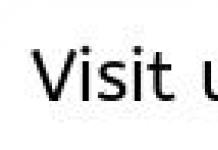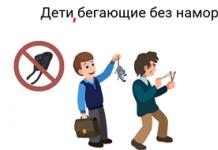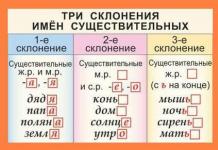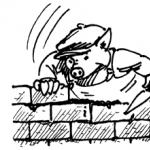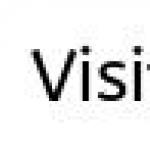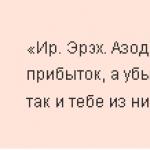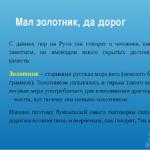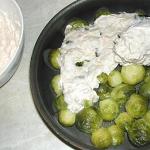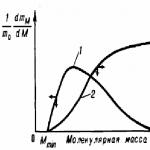§ 47.1
Direct speech stands out in quotation marks, if it goes to line(to selection): Vladimir Sergeevich... looked at his man with bewilderment and said in a hasty whisper: "Go find out who it is"(T.).
If direct speech begins from a paragraph, then before starting it is placed dash:
...Nikita, bowing to the ground, said:
- Sorry, father.(M.G.).
§ 47.2
Regardless of the place occupied in relation to the author's words, in quotation marks inner speech, unspoken thoughts stand out: I look after him and think: “Why do such people live?”(M.G.); “There’s still something pathetic about her,” - I thought(Ch.).
§ 47.3
In quotation marks sounds transmitted in writing are highlighted (for example, echo): “Aw, Where You?" - the echo repeated loudly; The announcer's voice sounded clear: “We are passing on the latest news.”
To convey a telephone conversation in writing, punctuation that is more common for dialogue is used - dash between replicas (see § 51).
§ 47.4
In newspaper texts, quotation marks are often omitted when speaking directly: The French President said: The exchange of views was useful; Why is this happening?- asks the newspaper.
§ 47.5
Direct speech following the author's words is preceded by a colon, and the first word of direct speech is written with capital letters. Question and exclamation marks, and ellipses are placed before the closing quotation marks, and dot- after them. For example: Finally I told her: “Do you want to go for a walk on the rampart?”(L.); Lying on the bale and plan, he twitched his arms and legs and whispered: "Mother! Mother!"(Ch.); They shouted: “Two... Orderlies... Look, look - it’s still flying... Climb under the cars...”(A.T.); The hostess very often addressed Chichikov with the words: "You took very little"(G.).
§ 47.6
If direct speech begins with a paragraph, then a colon is not always placed after the preceding author’s words.
1) Colon put if the author's words contain a verb with the meaning of speech-thought ( speak, say, tell, notice, address, exclaim, shout, whisper, ask, inquire, answer, insert, interrupt, speak, begin, continue, confirm, explain, agree, assent, remind, advise, reproach, decide, think etc.) or a noun close in meaning or formation to verbs of speech-thought ( question, answer, words, exclamation, voice, whisper, sound, cry, thought and so on.).
In addition, in the function of words introducing direct speech, verbs are used that denote the speaker’s feelings, his sensations, and internal state ( remember, rejoice, be sad, be surprised, be offended, be indignant, be horrified etc.), as well as verbs denoting facial expressions, gestures, movements ( smile, grin, laugh, laugh, sigh, frown, come up, run up, jump up and so on.). Both verbs allow the possibility of adding verbs of speech to them ( rejoiced and said: was surprised and asked; smiled and answered; ran up and exclaimed etc.), therefore they are perceived as words introducing direct speech. For example:
A) He looked with a grin:
- It’s okay, it’ll heal before the wedding.
b) While they were digging out the wheels stuck in the sand, a policeman approached us:
- Who are they?
V) The mother frowned:
- Did you get a bad grade again?
G) Everyone was horrified:
- Is that really true?
d) The old man got angry:
- Get out of here immediately!
e) The children ran towards their mother: - Mama!
and) This time he got angry:
- You won’t get another gram!
h) Snatching a log, she began to hit it on the basin:
- Climb! Get up!
Wed: On one of these... days Zabrodsky came running: “Dmitry Alekseevich, it has begun!..”(Er.)
Colon is also placed in cases where the author’s words do not contain verbs of speech or verbs replacing them with the above meanings, but the situation shows that direct speech is being introduced: ...And he said to him: “This is our common house.”(Ch.); ...And he: “Get away, you drunken face!”(M.G.); ...And he: “I’m a writer. Not a prose writer. No, I’m in touch with the muses"(M.).
2) The colon is not placed if the words are inserted and said, and asked, and exclaimed etc. is impossible or difficult:
A) Nobody wanted to leave.
- Tell us something more about your travels.
b) My words clearly confused him.
- So you don't trust me?
V) He had no other choice.
- I accept your terms.
G) The mother's eyebrows furrowed.
- I don't allow you to do this.
d) The little driver's eyes sparkled.
e) - Wonderful! Renovated to perfection!
Wed: This morning she took money from my pocket before going to the bakery, and attacked this little book and pulled it out. “What do you have?” (Sh.) A colon is also not placed if direct speech is concluded between two sentences from the author, and the second of them contains words introducing direct speech:
He tore out several pieces of paper from the notebook and handed them to me.
- Write down my comments in detail, - he said in a calm voice.
§ 48. Direct speech before the author’s words
If direct speech comes before the author’s words, then after it there are comma (interrogative) or exclamation mark, ellipsis) and dash: the author's words begin with lowercase letters: “Mother probably isn’t sleeping, and I’m not coming back from work,” - thought Pavel(BUT.); “Do you know grandpa, mom?” - the son says to the mother(N.); “Don’t make noise, go quietly, soldier!” - the old man spoke to Olenin in an angry whisper.(L.T.); "I would like to buy peasants..." - said Chichikov, he faltered and did not finish his speech.(G.).
The same when formatting direct speech from a paragraph:
- Flattery and cowardice are the worst vices, - Asya said loudly(T.);
- Well, Natalya, haven’t you heard about your husband? - interrupted the Kashulinskaya daughter-in-law, turning to Natasha(Sh.);
- Hurry, hurry to the city for a doctor! - Vladimir shouted(P.);
- Sleep, grandson, sleep... - the old woman sighed(Ch.).
|
Notes: 1. After the closing quotation marks only dash(regardless of what punctuation mark ends direct speech) in cases where the subsequent author’s words contain a characteristic of direct speech, its assessment, etc. (the author’s remark begins with the words he says this, he points out this way, this is what he said, this is how he describes and so on.): "Nothing happened" - so spoke the mind; "It happened" - so spoke the heart; “There is nothing more beautiful than these snowy peaks” - This is how one traveler describes this area; “Be careful and careful!” - that's what he told me goodbye. The same if the connecting structure follows: “Every vegetable has its time” - This folk wisdom is passed down from century to century. - Hurry, the school is on fire! - And he ran home to wake people up. |
§ 49. Author's words inside direct speech
§ 49.1
If the author’s words are inside direct speech (set off in quotation marks), then quotes are placed only at the beginning and at the end of direct speech and are not placed between direct speech and the author’s words (such punctuation was found in the works of writers of the 19th century): “I came to command,” Chapaev stated, - instead of fiddling with papers"(Furm.).
|
Notes: 1. A special case of punctuation when breaking words enclosed in quotation marks (names of literary works, various enterprises, etc.) is found in the following example: “Spade...” is this “...queen”?(interlocutor’s remark in response to the statement that the presented text is an excerpt from “The Queen of Spades”). 2. Direct speech is not highlighted in quotation marks in the following cases: 1) if there is no exact indication of who it belongs to, or if a well-known proverb or saying is given: They said about Ivashka Brovkin: strong(A.T.); It’s easier to be sick at home and it’s cheaper to live; and it’s not for nothing that it says: houses and walls help (Ch.); 2) if direct speech is given in a form that indirect speech with the same lexical composition can have: But it occurs to me: Is it really worth telling my life? (T.); 3) if in the middle of direct speech is inserted the word speaks playing the role of an introductory word indicating the source of the message: I'll die speaks, and thank God, speaks; I don't want speaks, live(T.); I say I want to kill the gendarmerie sergeant himself with a pistol(Versh.); 4) if in the middle of a sentence, which is a message from a periodical press, an indication of the source of the message is inserted (such an insertion is highlighted by one commas): The speaker's speech the correspondent continues, evoked warm support from the majority of those present. The same if the speaker’s statement is conveyed approximately (thereby losing the character of direct speech): The proposed project, the speaker indicated, has already been tested in practice. |
§ 49.2
If at the point where direct speech is broken by the author’s words there should be no punctuation mark or there should be a comma, semicolon, colon or dash, then the author’s words are highlighted on both sides commas and dashes, after which the first word is written with lowercase letters: "We decided - the assessor continued, - with your permission to stay here overnight"(P.) - there would be no sign at the site of the rupture; "No, - Ermolai said, - things are not going well; we need to get a boat"(T.) - there would be a comma at the place of the break; “We’ll have to spend the night here,” said Maxim Maksimych, “You can’t cross the mountains in such a snowstorm.”(L.) - at the place of the break there would be a colon.
§ 49.3
If there should be a dot where the direct speech breaks with the author’s words, then the author’s words are preceded by comma and dash, and after them - dot and dash; capital letters: “I am not connected with anyone or anything, - he reminded himself. “Reality is hostile to me.”(M.G.); “You want to cripple me, Lenochka, - Voropaev shook his head. “Well, can I get there?”(Paul.)
§ 49.4
If at the place where direct speech breaks in the author's words there should be interrogative or Exclamation point, then this sign is preserved before the author’s words and is placed after it dash; the author's words begin with lowercase letters followed by dot and dash; the second part of direct speech begins with capital letters: “So your name is Pavka? - Tonya broke the silence. - Why Pavel? It doesn’t sound nice, it’s better Pavel”(BUT.); “Here it is, the end of the world! - exclaimed Mokhov. - Great! I’ve never traveled this far before!”(Already)
§ 49.5
If in place of the break in direct speech by the author’s words there should be ellipses, then it is saved before the author’s words and placed after it dash; after the words of the author are placed or comma and dash(if the second part of direct speech does not form an independent sentence, it begins with lowercase letters), or dot and dash(if the second part is a new sentence, begins with a capital letter): "No need…- With Vershinin said, - no need, guy!(Vs.Iv.); “Wait... - Morozka said gloomily. - Give me a letter..."(F.) 6. If in the author’s words inside direct speech there are two verbs with the meaning of a statement, of which one refers to the first part of direct speech, and the other to the second, then after the author’s words are placed colon and dash, and the first word of the second part begins with capital letters: “I’m not asking you,” the officer said sternly and asked again: “Old woman, answer!”(M.G.); “I humbly thank you, - responded Meshkov, humbly took off his cap, but immediately put it on again and bowed, adding hastily: - Thank you very much, comrades"(Fed.).
§ 50. Direct speech within the author’s words
A) Father Vasily raised his eyebrows and smoked, blowing smoke from his nose, then said: "Yes, that's how it is" sighed, paused and left(A.T.) - a comma separates homogeneous predicates said And sighed, between which there is direct speech; ...Sofya Karlovna kissed Manya again and said to her: “Go for a walk, my baby,” she trudged behind her screens(Lesk.) - a comma closes the adverbial phrase, which includes direct speech; Boris comes up to me and says: “Well shot, great” but his eyes sparkle, full of envy(Kud.) - a comma separates parts of a complex sentence connected by an adversative conjunction But; Arriving at the dacha in a large company... my brother suddenly said: “Bear, let’s go to billiards” and they locked themselves in and played billiards for three hours(Sim.) - comma before the conjunction And in a complex sentence;
b) …She said: “Nowadays, they say, they don’t do much science at the university anymore.” - and called her dog Suzette(L.T.) - dash before the conjunction And with homogeneous predicates; At this point he was completely stupefied: “Your Honor, Father Master, how are you... am I even worth it...” - and suddenly cried(Add.) - a dash after the ellipsis, which ends direct speech; To my question: “Is the old caretaker alive?” - no one could give me a satisfactory answer(P.) - a dash after a question mark, which ends direct speech; And only when he whispered: "Mother! Mother!" - he seemed to feel better(Ch.) - a dash after the exclamation mark, which ends direct speech; Don't say: "Hey, dog!" or “Hey, cat!” - two lines separated by a non-repeating conjunction or;
V) When the clerk said: “It would be nice, master, to do this and that,” - "Yes, not bad" - he usually answered(G.); When a man came to him and, scratching the back of his head with his hand, said: “Master, let me leave for work, let me earn some money,” - “Go,” - he said(G.) - a comma and a dash separate two remarks from different persons located inside the author’s words.
|
Note. Genuine expressions inserted into the text as sentence elements are highlighted in quotation marks, but they are not preceded by a colon: This “I don’t want” struck Anton Prokofievich(G.); The orderly's assumption is that “The platoon commander got drunk and is sleeping somewhere in a hut,” gathered more and more supporters(F.); He remembered the proverb "You're chasing two hares - You won’t catch a single one.” and abandoned the original plan; With a scream "Save the Children!" the young man rushed into the burning building. But if before the original expression there are words sentence, expression, inscription etc., then before them is placed colon: Above the gate stood a sign depicting a portly cupid with an overturned torch in his hand, with the caption: “Plain and painted coffins are sold and upholstered here...”(P.); Fast trains with signs on the cars rushed past the station: "Moscow - Vladivostok"; Parse the sentence: “Lightning flashed and thunder roared.” |
§ 51. Punctuation marks in dialogue
§ 51.1
If dialogue lines are given every from a paragraph, then it is put in front of them dash:
- So the German is calm?
- Silence.
- Rockets?
- Yes, but not very often(Kaz.).
§ 51.2
If the cues follow in selection without indicating who they belong to, then each of them is concluded in quotes and separates from the neighboring one dash: “So are you married? I didn't know before! How long ago?” - "About two years". - "On whom?" - “On Larina.” - “Tatyana?” - “Do you know her?” - “I’m their neighbor”(P.).
§ 51.3
“You can’t see it?” - the master repeated. “Not to be seen,” the servant answered a second time.(T.);
“How are you doing?” - asked Ekaterina Ivanovna. “Nothing, we live little by little,” answered Startsev (Ch.);
“Will you allow me to go to the first company?” - said Maslennikov, diligently, more than usual, stretching out in front of Saburov. “Go,” said Saburov. “I’ll come to you soon too.”(Sim.).
§ 51.4
If one replica is interrupted by another, and then a continuation of the first replica follows, then after the first part and before the beginning of the second, put ellipsis:
- I requested…
- You didn't ask for anything.
- ...at least a minute of attention.
§ 51.5
If the subsequent remark repeats words from the previous one, belonging to another person, and they are perceived as someone else’s text, then these words are highlighted in quotation marks:
Kupavina. Ah, this is finally funny. Why be a lawyer when there is nothing.
Lynyaev. How about “nothing”?
Kupavina. Okay, nothing, blank paper(Acute);
Silan. Walk a little, it’s better for you...
Kuroslepov. Yes,« take a walk a little"! All your consideration...(Sharp).
Wed: “If you are free, come see me.” - "Like this " you will be free" ? After all, every minute counts for me”; “Believe me, you are still dear to me.” - “Yours” roads “Totally inappropriate,” she got angry.
If the words repeated in the subsequent remark are not perceived as someone else’s text, then they are not highlighted in quotation marks:
Lynyaev. Alas!
Murzavetsky. What is “alas”? What is it, dear sir, alas?(Ostr.) - first alas - repetition of a word from someone else’s text, the second - a word from one’s own text.
§ 51.6
A special form of constructing a dialogue is expressed in the fact that punctuation marks are used as independent remarks - mainly question marks and exclamation marks:
A) - I will not answer.
- What will this give you?
- It won't give anything. We'll find out everything.
b) - “You’re crazy,” said Proshkin, seeing my second copyright certificate for the invention.
This peculiar use of them is explained by the fact that “the meaning of exclamation and question marks is so definite and generally accepted that it turns out to be possible with the help of these signs to express surprise, doubt, indignation, etc. ... even without words” (cf. § 2, p. 6 and § 3, paragraph 7).
§ 52. Paragraphs in direct speech
§ 52.1
He grabbed the pole, told Dina to hold it, and climbed. It broke off twice—the block was in the way. Kostylin supported him and somehow made it to the top. Dina pulls him by the shirt with her little hands, with all her might, laughing herself.
Zhilin took the pole and said:
- Take it to its place, Dina, otherwise they’ll miss it, - they'll kill you(L.T.).
But if the sentence introducing direct speech begins with a connecting conjunction and, but etc., then it is not highlighted in a separate paragraph:
They talked some more and began to argue about something. AND Pakhom asked what they were arguing about. And the translator said:
“Some people say that you need to ask the foreman about the land, but you can’t do it without him.” And others say it’s possible without it(L.T.).
§ 52.2
- Well, I’m very glad,” said the wife, “so now, look, take the medicine carefully.” Give me the prescription, I'll send Gerasim to the pharmacy. - And she went to get dressed.
He didn't catch his breath while she was in the room and sighed heavily when she left.(L.T.).
- When? - many exclaimed. And meanwhile their eyes were fixed in disbelief on the hunchback, who, after a moment of silence, stood up, saddled his horse, put on his horn, and rode out of the yard (L.).
§ 52.3
- “I’m sure,” I continued, “that the princess is already in love with you.” He turned red to his ears and pouted(L.).
§ 52.4
If between two remarks of the same speaker there is text from the author, then neither this text nor subsequent direct speech is usually separated into separate paragraphs:
- This formula may have a different form,” the professor explained. He leisurely walked up to the blackboard, took the chalk and wrote something new for us.
“This is another option,” he said.
In poetic texts, there are also cases when direct speech, interrupted by the author’s words (remark), is a continuation of the previous one, or when his action is described between two remarks of the same person: in the first case dash placed on the right, at the end of the line, in the second - on the left, at the beginning of the line (like a paragraph): You demand a lot, Emilia!- (Silence.) Who would have thought that such a fool, So insensitive... nature is boring!..(L.) You are a scoundrel, and I will mark you here, so that everyone will consider it an insult to meet you.
(Throws cards in his face. The prince is so amazed that he does not know what to do.) - Now we're even(L.).
In verses, after direct speech ending before a space, there is no dash.
§ 52.5
If direct speech is a dialogue that occurred earlier, it can be formatted either in paragraphs or in selection, but the punctuation changes depending on whether the listener interrupts the narrator or not. If he interrupts, then the conversation that took place earlier is given from paragraphs and in quotes, so that the phrases of the narrator and the listener are not mixed with the dialogue given by the narrator. For example:
-
"We'll have to stay for a while." "Why? Something happened?"
-
- I'll tell you now.
Another option: the words of the previously occurring dialogue are given in selection to the words and says between phrases contained in quotes, is put dash:
...The traveler began his story:
- This was at the very height of our hike. The guide came up to me and said: “We’ll have to stay for a while.” - "Why? Something happened?"
- Did anything really happen? - one of those listening to the traveler could not stand it.
- I'll tell you now.
If the listener does not interrupt the narrator, then the dialogue given in the story can also be framed in two ways: either by dash from paragraphs, or in selection, and in this case, the replicas are enclosed in quotation marks and separated by the sign dash. Wed:
a) ...The traveler began his story:
- This was at the very height of our hike. The guide came up to me and said:
- We'll have to stay for a while.
- Why? Something happened?
- There was a landslide in the mountains.
- Are there any unpleasant consequences?
- I'll find out the details. But it is already known that there are victims.
b) ...The traveler began his story:
This was at the very height of our hike. The conductor came up to me and said: “We’ll have to stay for a while.” - "Why? Something happened?" - “There was a collapse in the mountains.” - “Are there any unpleasant consequences?” - “I’ll find out the details. But it is already known that there are victims.”
Those present listened attentively to the traveler's story.
If the dialogue given in the replica is accompanied by the author’s words, then it is given in selection and stands out in quotation marks:
Balzaminov. ...They look and smile, and I pretend to be a lover. Only once we meet Lukyan Lukyanovich (I didn’t know him then), and he says: “Who are you chasing here?” I speak: “I’m with the eldest.” And he said so at random...(Sharp)
§ 52.6
If direct speech conveying unspoken thoughts is given after the author’s words, then it does not stand out from the paragraph:
Everything was going smoothly. Suddenly he caught himself and thought: “ Is there some kind of catch here? »
A) Everything was going smoothly.
“Isn’t there some kind of catch here,” he thought?
b) Everything was going smoothly.
“Isn’t there some kind of catch here?” - he thought.
§ 52.7
If a long story with many paragraphs is being transmitted, then dash is placed only before the first paragraph (neither before intermediate paragraphs nor before the last dash):
- The work of our expedition went like this,” the geologist began his story.- B A detailed plan was developed, routes were outlined..[The story continues.]
These are the preliminary results of the expedition.
§ 53. Punctuation and graphic design of text in plays
§ 53.1
Prose text in plays is given to match the name of the character (the latter is highlighted in font); A dot is placed after the name of the character:
Anna Pavlovna. Where is Viktor Mikhailovich? Lisa. Left. (L.T.)
§ 53.2
In poetic texts, there is no period after the name of the character, given on a separate line and left out in the middle:
Nina
Death, death! He's right - there's fire in the chest - all hell.
Arbenin
Yes, I served you poison at the ball. (L.)
§ 53.3
Act one
The theater represents the front room of a rich house in Moscow. Three doors: the outer one, to Leonid Fedorovich’s office and to Vasily Leoniditch’s room.
Staircase up to the inner chambers; Behind her is a passage to the buffet. (L.T.)
§ 53.4
In remarks placed next to the name of the character and highlighted in a different font (usually italics) in brackets, a period is placed after the bracket:
Manefa (To Glumov). Run away from the bustle, run away.
Glumov (with a lean look and sighs). I'm running away, running away. (Sharp)
§ 53.5
Remarks in the text relating to a given person, if the remark is followed by a new phrase from the same person or if the remark ends with a remark, begin with a capital letter, italicized in brackets, with a period inside the bracket:
a) E p i h o d o v. I will go. (Bumps into a chair, which falls.) Here… (As if triumphant.) You see, excuse the expression, what a circumstance, by the way... (Ch.)
b) A n f i s a (seeing Lynyaev). Oh, you're... you're on your own. (Goes to the garden.)(Sharp)
If the remark is in the middle of the character’s phrase, it begins with a lowercase letter and is italicized in brackets, without a period:
N i k i t a. Now I'll go (looks around) left.
§ 53.6
In poetic texts, remarks relating to a given person, if adjacent to the name of the character, are given in italics in brackets without a dot; if the actor’s remarks come in the middle (or at the end of the text), they are highlighted on a separate line and given in italics in brackets with a dot:
Arben (listens)
You're lying! He is here
(points to the office)
And, surely, he sleeps sweetly: listen,
how he breathes.
(To the side.)
But it will stop soon.
Sl u g a (to the side)
He hears everything... (L.)
§ 53.7
A remark relating to another character is usually typed in a smaller font and included in a red line, without parentheses:
Lyubov Andreevna. Where are you! Just sit...
Firs enters; he brought a coat.(Ch.)
§ 53.8
If in the middle of one person’s remark there is a remark relating to another person or a remark of a general nature (for example, It's getting dark or Songs are heard), then the remark is turned off, as usual, in a red line, without brackets, and the continuation of the speech of the previously speaking person (before the remark) is given on a new line without a paragraph, and the name of the character is not repeated:
SERGEY PETROVICH. Come with me to the house.
The clatter of dishes is heard in the kitchen.
So dinner is prepared for us.
The name of the character is repeated in cases where there is a remark relating to him:
Lyubov Andreevna. You needed giants... They are only good in fairy tales, but they are so scary.
Epikhodov passes at the back of the stage and plays the guitar.
Lyubov Andreevna (thoughtfully). Epikhodov is coming. (Ch.)
§ 53.9
If a poetic line is split into parts (in one line the speech of several characters is given), then this line is formatted as a “ladder”, that is, the beginning of the text of the second character’s remark will be at the level where the text of the previously speaking person’s remark ended:
1st po nter
Ivan Ilyich, let me put it.
B a n c o m e t
If you please.
1st po nter
One hundred rubles.
B a n c o m e t
2nd po nter
Well, good luck. (L.)
Rules of Russian spelling and punctuation. Complete academic reference book Lopatin Vladimir Vladimirovich
Punctuation marks for direct speech
§ 133. Direct speech, i.e., the speech of another person, included in the author’s text and reproduced verbatim, is formatted in two ways.
1. If direct speech is included in a line (in a selection), then it is enclosed in quotation marks: « I regret that I didn't know your father“,” she said after a while. - He must have been very kind, very serious, loved you very much" Luzhin remained silent(Eb.).
2. If direct speech begins with a paragraph, then a dash is placed in front of it (there are no quotation marks):
Fedya and Kuzma were silent. Kuzma quietly winked at Fedya, and they went out into the street.
- This is what I came for: Did the Lyubavins come from mowing?
- We've arrived.
- Take Yasha and wait for me here. I'll pop home in a minute(Shuksh.).
Both methods of formatting direct speech can be combined if the speech of one person also includes the direct speech of another person:
- Did I say so?
- Oh, terrible fool!(Bond.).
- Did you have a dream?
- I saw it. It’s as if my father and I went to trade a horse, we both liked one horse, my father blinks at me: “ Jump and ride» (Shuksh.).
§ 134. If direct speech is worth before introducing it in the author's words, then after direct speech a comma and a dash are placed, and the author’s words begin with a lowercase letter: “We understand everything perfectly, Nikolai Vasilyevich,” Solodovnikov quipped to himself, sitting down on a white stool.(Shuksh.). If after direct speech there is a question mark, exclamation mark or ellipsis, then these marks are preserved and a comma is not placed; the author’s words, as in the first case, begin with a lowercase letter: “Yes, I should have said goodbye!..” - he realized when the covered car was already climbing up(Shuksh.); “My blue-eyed guardian angel, why are you looking at me with such sad anxiety?” - Krymov wanted to say ironically(Bond.).
If direct speech is worth after the author's words, then these words end with a colon; punctuation marks after direct speech are preserved: I I tell him: “Don’t cry, Egor, don’t”(Spread); Philip mechanically moved the steering oar and kept thinking: “Maryushka, Marya...”(Shuksh.); I wanted to get to the “office” as quickly as possible, to pick up the phone as quickly as possible, to hear Dolin’s familiar voice as quickly as possible: “Is that you? It’s necessary, huh?”(Sol.).
1. If at the rupture site turns out exclamation or question mark, then it is saved, followed by a dash before the words of the author (with lowercase letters), after these words a dot and a dash are placed; the second part of direct speech begins with a capital letter: “Do I now give happiness to many people, as I did before? - thought Kiprensky. “Is it really only fools who try to arrange the well-being of their lives?”(Paust.); “Yes, be quiet! - ordered the duty officer. “Can you be quiet?!”(Shuksh.).
2. If at the rupture site there should be direct speech ellipses, then it is saved and a dash is placed after it; after the author’s words, a comma and a dash are placed if the second part of direct speech is not an independent sentence, or a dot and a dash if the second part of direct speech is an independent sentence; the second part of direct speech begins with a lowercase or capital letter, respectively: “Probably the mistress is having a fit...,” Mashenka thought, “or she had a fight with her husband...”(Ch.); “Wait...,” Lenka shouted, freeing his flaxen hair from his grandfather’s clumsy, trembling fingers, perking up a little. - As you say? Dust?"(M.G.).
3. If at the rupture site direct speech there should be no punctuation mark or there should be mid-sentence marks: comma, semicolon, colon, dash, then the author’s words are highlighted with a comma and a dash; the second part of direct speech begins with a lowercase letter: “You can’t understand,” I whisper, calling Ruslan into the next room and closing the door, “because we are different creatures.”(Trif.); “So, it’s wilted a little, on one side,” Asya giggled in a youthful way, wrinkles scattering across her face, “like a stale apple.”(Trif.); “Suddenly you sow,” Semyon thought, “and ordinary barley grows. Most likely this will happen."(Sol.); “Yes, something is biting badly,” said Fog, “it hurts when it’s hot.”(T.); “But how will you play,” Darwin said in response to his thoughts, “that, of course, is the question.”(Eb.).
4. If at the rupture site there should be direct speech dot, then a comma and a dash are placed before the author’s words, and a dot and a dash are placed after these words; the second part of direct speech begins with a capital letter: “They were disbanded before the verdict,” Dvornik said. “They will announce it tomorrow at nine o’clock in the evening.”(Trif.).
5. If the author's words break apart within the meaning of into two parts, which relate to different parts of direct speech, then if other conditions are met, a colon and a dash are placed after the author’s words: “Ehma... - hopelessly sighed Gavrila in response to a stern order And bitterly added: “My fate is lost!”(M.G.); “Don't touch the uniform! - ordered Lermontov and added, not at all angry, but even with some curiosity: “Are you going to listen to me or not?”(Paust.); “Have you ever smelled copper on your hands? - asked unexpectedly the engraver and, without waiting for an answer, winced and continued: - Poisonous, disgusting"(Paust.).
§ 136. If direct speech turns out to be inside the author's words, then it is enclosed in quotation marks and preceded by a colon; direct speech begins with a capital letter. After direct speech, punctuation marks are placed as follows:
a) a comma is placed if it was necessary at the break in the author’s introductory words: Saying, “See you soon,” she quickly left the room.;
b) a dash is placed if there is no punctuation mark at the break in the author’s introductory words: Overcoming awkwardness, he muttered a student witticism: “My grandmother fell ill with measles” - and wanted to give the conversation that had begun a casual lightness(Bond.);
c) a dash is placed if direct speech ends with an ellipsis, question mark or exclamation mark: The children expected him to praise them, but the grandfather, shaking his head, said: “This stone has been lying here for many years, this is where it belongs...” - and told about the feat of three Soviet intelligence officers(Dry); Pyotr Mikhailych wanted to say: “Please don’t get involved in your own affairs!” - but remained silent(Ch.); She[dog] stops. I repeat: “What is said?” - and I keep it on the counter for a long time(Priv.);
d) if direct speech is directly included in the author’s sentence as its member, then it is enclosed in quotation marks, and punctuation marks are placed according to the terms of the author’s sentence: Having told Grichmar the phrase “There is no easy life, there is only an easy death,” Krymov caught Stishov’s restless, warning glance(Bond.).
Note. Direct speech is not highlighted in quotation marks:
a) if there is no precise indication of who it belongs to (direct speech is introduced by an impersonal or vaguely personal sentence): It’s not for nothing that they say: the master’s work is afraid(last); They said about him: strict, but fair;
b) if an introductory word is inserted into direct speech speaks indicating the source of the message: He says, I want to finish college and get a profession.; or if a direct indication of the source of the message is framed as an introductory construction: The scientist’s article, the critic reports, aroused great public interest.
§ 137. If direct speech belongs to different persons, then each replica is highlighted separately in quotation marks:
a) replicas are separated from each other by a dash: “Is the samovar ready?” - “Not yet...” - “Why? Someone came there." - “Avdotya Gavrilovna”(M.G.);
b) if one of the remarks is accompanied by introducing author’s words, then the next one is not separated by a dash: “You’re a widow, aren’t you?” - he asked quietly. "Third year". - “How long were you married?” - “A year and five months...”(M.G.);
c) a dot and a dash are placed between replicas belonging to different persons and equipped with different author’s words: As he passed by, he said, “Don’t forget to buy tickets.” “I’ll try,” I replied.; if the first replica contains exclamation or question marks, the period is omitted: As he passed by, he shouted: “Cheer up!” “I’ll try,” I replied.;
d) a comma and a dash are placed between remarks belonging to different persons, but united by a common author’s sentence: When the clerk said: “It would be good, master, to do this and that,” “Yes, not bad,” he usually answered.(G.); if the first replica contains exclamation or question marks, the comma is omitted: When I asked, “Why do you wear a carpet on your back?” “I’m cold,” he replied.; the same with a different arrangement of parts of the author’s sentence: When I asked, “Why do you wear a carpet on your back?” - he replied: “I’m cold”(Current.).
§ 138. When paragraph allocation lines of dialogue is placed before the replica dash; After the author's words preceding the dialogue, a colon or period is placed. If the author’s text contains words introducing direct speech, then a colon is placed after them; if there are no such words, then a dot is added:
Carmen took her hand away; the unfinished beat froze with a questioning ringing.
“I’ll finish the game,” she said.
- When?
- When you're with me(Green).
The telegraph operator, a stern, dry woman, having read the telegram, suggested:
- Make it up differently. You are an adult, not in kindergarten.
- Why? - asked the Weird. - I always write to her like this in letters. This is my wife!.. You probably thought...
- You can write whatever you want in letters, but a telegram is a type of communication. This is clear text.
The weirdo rewrote(Shuksh.).
The same with a single replica:
Shatsky walked around the room.
- Stuffiness, stuffiness! - he muttered. - The evenings here cause asthma(Paust.).
His eyes are lowered to his plate. Then he raised them to Nadya, ordinary blue eyes, smiled and said quietly:
- Excuse me. It's my fault. This is childish of me(Sol.).
§ 139. Paragraph and non-paragraph (with the help of quotation marks) highlighting of direct speech is used differentially. If the text alternates between external speech (addressed to the interlocutor) and internal speech (thought to oneself), then external speech is formatted using paragraph highlighting, and internal speech is formatted using quotation marks:
- Hm-yes. Well, you're right. Business cannot be exchanged for idleness. Go ahead and draw your triangles.
Nadya looked pleadingly into Ivan’s eyes. “Well, what’s so scary about that,” I wanted to tell her. - Tomorrow will be a new evening, we can go to the White Mountains. And the day after tomorrow. But it’s not my fault if I promised two weeks ago.”(Sol.).
And after my words, he smiled from ear to ear (his mouth was just from ear to ear) and joyfully agreed:
- Okay, then let's go.
“Here I’ll show you, let’s go,” - I thought to myself (Sol.).
Only the inner ( thought to myself) speech in the author’s text, outside of dialogue:
Kuzma looked where they pointed. There, on the slope of another slope, mowers walked in a chain. Behind them, the mown grass remained in even lines - beautiful. “One of them is Marya,” - Kuzma thought calmly (Shuksh.); Kuzma looked at her with joy. “What else was I, a fool, looking for?” - he thought (Shuksh.).
From the book Handbook of the Russian Language. Punctuation author Rosenthal Dietmar ElyashevichSECTION 1 Punctuation marks at the end of a sentence and during a break in speech § 1. Period 1. The period is placed at the end of a complete narrative sentence: A dark leaden mass is crawling towards the sun. Lightning flashes here and there in red zigzags. Distant can be heard
From the book Handbook of Spelling and Stylistics author Rosenthal Dietmar ElyashevichSECTION 14 Punctuation marks for direct speech § 47. Direct speech after the author’s words 1. Direct speech is highlighted in quotation marks if it goes in a line (in a selection): Vladimir Sergeevich... looked at his man with bewilderment and said in a hasty whisper: “Go find out who This"
From the book Handbook of Spelling, Pronunciation, Literary Editing author Rosenthal Dietmar Elyashevich§ 49. Author's words inside direct speech 1. If the author's words are inside direct speech (highlighted by quotation marks), then quotation marks are placed only at the beginning and at the end of direct speech and are not placed between direct speech and the author's words (such punctuation was found in works
From the book Rules of Russian Spelling and Punctuation. Complete Academic Reference author Lopatin Vladimir Vladimirovich§ 52. Paragraphs for direct speech 1. If first there is a text from the author (introductory part, description, etc.), and then a sentence introducing direct speech, then it usually begins with the paragraph: He grabbed the pole, told Dina to hold it and useful It broke off twice—the block was in the way. Supported
From the book Rock Encyclopedia. Popular music in Leningrad-Petersburg, 1965–2005. Volume 1 author Burlaka Andrey PetrovichSECTION 21 Punctuation marks in texts and colloquial speech Various difficulties arise in the punctuation of colloquial texts. In some cases, it seems possible to find some relationships between the structures of colloquial speech and
From the author's bookXX. Punctuation marks at the end of a sentence and during a break in speech § 75. Period 1. The period is placed at the end of a complete narrative sentence, for example: The shadow was thinning. The East is red. The Cossack fire burned (Pushkin). Note. A period is not placed at the end of a sentence after a period,
From the author's bookXXXI. Punctuation marks for direct speech § 119. Direct speech after the author's words Direct speech is highlighted in quotation marks if it goes into a line (in a selection), for example: Stunning news burst into a small town like a whirlwind: “The Tsar has been overthrown!” (N. Ostrovsky). If direct speech begins with
From the author's book§ 121. Author's words inside direct speech If the author's words are inside direct speech, highlighted by quotation marks, then the latter are placed only at the beginning and at the end of direct speech and are not placed between direct speech and the author's words. For example: “I came to command,” said
From the author's bookXX. PUNCTION MARKS AT THE END OF SENTENCES AND WHEN SPEECH BREAKS § 75. Period 1. The period is placed at the end of a complete narrative sentence, for example: The shadow was thinning. The East is red. The Cossack fire burned (Pushkin). Note. A period is not placed at the end of a sentence after a period,
From the author's bookXXXI. PUNCTION MARKS FOR DIRECT SPEECH § 119. Direct speech after the author's words1. Direct speech is highlighted in quotation marks if it goes into a line (in a selection), for example: Remember often the words of L. Tolstoy: “A person has only responsibilities.” If direct speech begins with a paragraph, then
From the author's book§ 121. Author's words inside direct speech 1. If the author's words are inside direct speech, highlighted by quotation marks, then the latter are placed only at the beginning and at the end of direct speech and are not placed between direct speech and the author's words, for example: “I can read, - first again
From the author's bookPUNCIPATION MARKS AT THE END AND AT THE BEGINNING OF SENTENCES. ENDING SIGNS IN THE MIDDLE OF A SENTENCE Punctuation marks at the end of a sentence § 1. Depending on the purpose of the message, the presence or absence of emotional overtones of the statement, a period is placed at the end of the sentence
From the author's bookPUNCTION MARKS FOR DIRECT SPEECH AND QUOTES
From the author's bookPunctuation marks for direct speech § 133. Direct speech, that is, the speech of another person included in the author's text and reproduced verbatim, is formatted in two ways.1. If direct speech is in a line (in a selection), then it is enclosed in quotation marks: “I regret that I did not know your father,”
From the author's bookthe relationship between direct speech and the author's words direct speech before the author's words § 134 direct speech after the author's words § 134 the author's words break direct speech § 135, paragraphs. 1, 2, 4, 5 the author’s words fall into two parts § 135, paragraph 5 direct speech within the author’s words § 136 direct speech belonging to
From the author's bookPUNCTUAL MARKS The group PUNCTION MARKS was born in June 1988 as a peculiar reaction to the change in musical direction in the popular St. Petersburg group of the second half of the 80s THE YOUNGER BROTHERS - from melodic neo-romanticism and electropop towards hard guitar
“We’re talking, we’re talking...” or punctuation rules for direct speech
All our words that form monologues, dialogues and polylogues are direct speech in. Another thing is how to correctly formulate this statement, correctly inserting it into the author’s thoughts in the letter. What is the difference between indirect and direct? And what punctuation marks are used to indicate it in Russian? Details in this article.
In contact with
Direct speech in Russian: what is it?
In fact, direct speech is called words of the speaker that are inserted verbatim in the author's thoughts. This format is distinguished by individuality and belongs to the person whose words are reproduced. A person can use dialecticisms, observe pauses, or saturate his statements with introductory constructions.
Attention! The introduction of this speech type does not provide for any additional conjunctions or pronouns.
The formatting of direct speech is usually highlighted using quotation marks or as a separate paragraph. As a variation, this can also include citation - this is the selection of the author's speech in quotation marks.
What is direct speech?
Design rules
How to write direct speech? The best way to remember punctuation is through diagrammatic rules.
Decoding of symbols: “P” – direct speech, “A” – words of the author.
 For a better understanding, here are examples for the left column of the diagrams:
For a better understanding, here are examples for the left column of the diagrams:
- He shouted: “It’s starting to rain!”
- He asked: “Has it started to rain yet?”
- He thought: “It will rain soon...”
- He shrugged: “It still rained.”
- "We are going to walk!" – she laughed.
- "We are going to walk?" – she asked.
- “We’re already walking,” she answered on the phone.
And last are the examples for the right column of the diagrams:
- He smiled: “Lunch was very tasty!” – and closed his eyes in pleasure.
- She looked at him: “Do you really think so?” – and was very surprised.
- He thought, looking into the distance: “Maybe you’re right...” and shook his head.
- She ran up to him: “Dad, take a maple leaf,” and held it out with her little hand.
“P, – a. - P".
In such complex cases, the entire statement along with the author's words is placed in quotation marks.
Example: “I’ll come later,” he said. “Have dinner without me.”
Important! This speech type is not a member of the sentence!

Punctuation schemes
How to format the dialogue correctly?
Dialogue is the exchange of remarks between two people, so in writing this type of speech is formalized without quotes, and each replica is written on a new line. Before the beginning of the statement there is also a dash.
Diagram of an example dialogue:
Where "R" is a replica.
Same verbal example:
– We went on an excursion today.
- To the paleontological museum.
- Great!
– Yes, it was very interesting!
Sometimes you can find an unusual dialogue that is drawn out into a line. This is done because the lines are very short. These dialogues are formatted according to the same rules as the inclusion of author’s words.
For example:
- Who's there? – she asked. - It's me!
If a sentence contains two constructions with direct speech and each is based on its own verb, then a dash is placed before the beginning of the “second” construction.
“Let’s go, it’s already getting dark,” he said and quietly asked: “Aren’t you cold?”
And the most interesting case is the following design, when several remarks, this can be both a dialogue and a polylogue (exchange of remarks by several people), follow each other in a line. Moreover, it is not indicated who owns these words, whether they are the words of the author or the heroes of the conversation. In this case, each replica is written in separate quotation marks and with a dash.
“P, – a, – p?” - "P". - "P?" - "P". - "P?" - "P".
For example:
“Tell me, grandma, this is what I asked,” I asked, “do you need any more help around the house?” – “Thank you, grandson, there is still work for you.” - “Which one, grandma?” - “Yes, screw the door to the closet.” - “How long has it been falling off?” - “It’s been two days already, it’s so inconvenient.”

Design of dialogues
Attention! Dash and hyphen are not identical. A dash is placed inside sentences or at the beginning of dialogue, and a hyphen divides only words into component parts.
Varieties: quotation and improperly direct speech
As mentioned above, quotation differs from direct speech in Russian in that the latter can be indirect. And the most important difference is that a quote with its uniqueness can also be member of the proposal. The only similarity between a quotation and a given speech type will be quotation marks: both are always formalized in writing with them.
Punctuation rules for quoting:
- If a quotation becomes an indirect statement or another part of a sentence that fits organically into the text, then it is placed in quotation marks and written with a lowercase letter. When analyzing a sentence, such a quotation is also parsed, like the author’s words. For example: “It was immediately clear to those who acted as independent judges on the show who was who, and they did not allow themselves to be deceived.
- If a quotation becomes a part of a sentence, then it is written with a capital letter and is highlighted with quotation marks when writing. Such quotation is also not considered direct speech.
For example: “The love boat crashed into everyday life” - this line is more than 80 years old.
 Standing apart is the improperly direct construction, which looks like a fragment of a narrative conveying thoughts, emotions, mood or attitude the depicted character. However, such direct speech with special intonation does not stand out in any way: neither syntactically nor punctuationally. The author of this technique in the literature is A.S. Pushkin, to speak and at the same time think for his character. This speech position is a translation of someone else's thoughts.
Standing apart is the improperly direct construction, which looks like a fragment of a narrative conveying thoughts, emotions, mood or attitude the depicted character. However, such direct speech with special intonation does not stand out in any way: neither syntactically nor punctuationally. The author of this technique in the literature is A.S. Pushkin, to speak and at the same time think for his character. This speech position is a translation of someone else's thoughts.
For example: This is his house. It is dilapidated, no one has been there for a long time. And here is the front door. God! How could he live here? There is a layer of dirt on the floor, the wallpaper is torn. A real hole!
This construction, naturally, is related to the author, therefore all pronouns and verb forms were chosen precisely from his position, but still such improperly direct speech has lexical and stylistic features that are inherent in our speech type. For example, the use of colloquial .

Examples of direct speech
When Andrei arrived home, his determination little by little evaporated... he looked out the window: Moscow was beautiful like spring. The townspeople admired the first dandelions...Where is Anna now? What is it like for her in a foreign land? Completely gone. What is she doing? Andrey returned to the computer and began typing the message again.
Mikhail Bakhtin first began to study the problem of this type of narration, and Voloshinov already spoke about its two-accent nature and the polyphony of such a tone of narration. Uspensky proposed to combine these constructions with the hero’s internal monologue and designate them as intermediate stage of transition of direct speech into indirect.
Sentences with direct speech. Punctuation marks in them
Sentences with direct speech. Ways to formulate someone else's speech
Conclusion
Thus, the answer to the question, what is direct speech, is the complete conviction that this is a rather important part of text fragments, since it absorbs not only the stylistic features of the speaker and reflects his individuality, but also conveys character traits, and also contributes to better understanding of the meaning. This type of speech makes the text more alive, saturates it with emotions and brings the reader closer to reality. And it’s not at all difficult to format it if you memorize simple punctuation rules schematically.
Instructions
You need to start by determining which parts of the sentence are words. First, determine the subject and predicate - the grammatical basis. This way you will already have a well-defined “stove” from which you can “dance”. Then we distribute the remaining words among the members of the sentence, taking into account the fact that they are all divided into a subject and a predicate group. In the first group, in the second - addition and circumstance. Please also take into account that some words are not members of the sentence (for example, conjunctions, interjections, introductory and inserted constructions), and that several words together make up one member of the sentence (adverbial and participial phrases).
So, you already have an initial sentence outline. If you remove the words themselves and leave only the lines that emphasize the members of the sentence, then this can already be considered a diagram. However, let's assume that in your case everything is more complicated. For example, your sentence is complicated, that is, for example, it contains an adverbial phrase. Such a turn is fully emphasized as a circumstance, and in the diagram it will be separated from the other lines by vertical lines: ,|_._._._._|,
If you have a complex sentence, then the diagram will need to reflect all the predicative parts that you will find in this community. The predicative part can be identified by searching for all grammatical bases in a sentence: one grammatical base - one predicative part. That is, if we have a complex sentence (that is, the parts in it are equal and one does not depend on the other), then we will highlight both parts with square brackets, and between them we will place a punctuation mark and a conjunction that connects them: , and .
If you have a complex sentence, then you will have to show all the relationships between the parts, since in such a sentence one part is subordinate to the other. The one that is obeyed is the main one, the one that obeys is the subordinate one. The main clause is indicated by square brackets, the subordinate clause by round brackets: , (which...). Such a scheme would be appropriate for a sentence, for example: “We saw the house that Jack built,” and the sentence would be a complex sentence with a attributive clause.
When creating your outline, consider your instructor's requirements as these may vary. Also, do not forget that the diagram is, as it were, a prelude to the analysis of the sentence, so the more you write in the diagram, the more you will be able to understand and then say. But do not overload the diagram: for example, there is often no need to show on the diagram of a large complex sentence all the members of the sentence that are there. Only the grammatical basis can be noted.
Our topic today is sentences with direct speech. Examples of such sentences are found everywhere: in fiction, magazines, newspapers, and journalistic materials. Already from the very name “direct speech” it becomes clear that in this case the author of the text conveys the words of a person exactly as they were spoken.
What is the difference between direct speech and indirect speech?
With direct speech, any utterance retains its characteristics - syntactic, lexical and stylistic. It is connected with the words of the author only in intonation and meaning, while remaining an independent construction.
If we are talking about sentences with indirect speech, then the author conveys someone else’s speech without its syntactic, stylistic and lexical features, keeping only the content of the statement unchanged. Moreover, depending on the author’s goals and context, the statement can be changed.
Let's take a closer look at sentences with direct speech. Examples of such structures might look like this:
- Ivan said: “Let’s quickly clean up the classroom and go to the park!”
- “It’s warm outside today,” Anna noted. “It seems like spring has finally come into its own.”
- “Would you like some tea?” - Daniel asked the guests.
Now let’s try to reformulate these same sentences so that instead of direct speech they use indirect speech:
- Ivan suggested quickly finishing cleaning the classroom and going to the park.
- Anna noted that it had become unusually warm outside and spring had finally come into its own.
- Daniel asked the guests if they would like to drink tea.

Basics of spelling sentences with direct speech
Punctuation when conveying direct speech directly depends on how the statement is positioned in a sentence relative to the words of the author.
Direct speech at the beginning of a sentence
The entire statement in this case is highlighted in quotation marks (“”). Depending on the type of exclamation or interrogative), the further transition to the author’s words may be different:
- for declarative sentences:“DIRECT SPEECH,” - the words of the author;
- for exclamatory (motivational) sentences:"DIRECT SPEECH!" - words of the author;
- for interrogative sentences:"DIRECT SPEECH?" - author's words.
Note! In declarative sentences, there is NOT a period at the end of the quotation. But an exclamation or an exclamation mark is a must. In addition, in declarative sentences there is a comma after the quotation marks, but in other cases there is not.
Here are some examples:
- “There will be a lot of mushrooms in the forest today,” the grandfather noted.
- “Do you think there will be a lot of mushrooms in the forest today?” - asked the boy.
- “There are so many mushrooms in the forest today!” - Zhenya exclaimed.

Direct speech at the end of a sentence
In another case, direct speech may be located after the author’s words. Here everything is much simpler: immediately after the author’s words a colon is placed, and the entire quote is again enclosed in quotation marks.
Let's consider similar sentences with direct speech. Examples might look like this:
- Anya said: “I read an interesting book.”
- The librarian asked: “Have you finished reading the book you borrowed a week ago?”
- Dima exclaimed: “I have never read a more interesting story in my life!”
Note! In a declarative sentence, quotation marks are closed first, and only then a period is added. But if you need to put an exclamation point, it must be placed exclusively inside quotation marks.
Direct speech between the words of the author
If a quote from someone’s statement is located between two fragments of the author’s words, the above rules seem to be combined.
Unclear? Then let's try with direct speech of this type:
- He said: “It looks like it will rain today,” and put the umbrella in his bag.
- Igor asked: “How are you doing?” - and handed his classmate a bouquet of wild flowers.
- Katya shouted: “Faster! All come here!" - and began to wave her arms vigorously to attract attention.
You already know these rules, and therefore there should be no problems with such offers at all - just be more careful!

Direct speech that is interrupted by the author's text
But this is a rather interesting type of proposal.
As always, direct speech begins with quotation marks. The author's words are preceded by a comma and a dash, and after that - a period, a dash and the continuation of the quotation. Wherein direct speech continues with a capital letter! At the end of a sentence, quotation marks are closed.
Let's look at such sentences with direct speech in practice. Examples that can be given in this case:
- “Let's buy a bouquet of flowers,” Lena suggested. “We’ll give it to mom.”
- “Grandma loves this set very much,” Roman noted. “My grandfather gave it to me.”
Note! If, due to a break in direct speech, the first part loses its semantic completeness and a feeling of understatement appears, then after the author’s words you need to put a comma, and the continuation of direct speech needs to begin lower case.
- “It would be nice,” said Igor, “it would be nice to walk along the embankment in the evening.”
- “It seems,” the girl noted, “they promised rain today.”
Simply put, if a sentence can be divided into two, and the reader will still understand everything, a period is needed. And if one of the fragments of direct speech individually does not carry any meaning, it makes sense to put a comma and continue the thought with a small letter.

Parsing sentences with direct speech
With direct speech, it is practically no different from ordinary speech. However, you will need, among other things, to name the author and direct speech, parse them (as two separate sentences), explain the placement of punctuation marks, and also draw a diagram.
This is how, in practice, direct speech turns out to be completely simple and understandable. The main thing is to analyze each example and try to create your own options based on the model.
